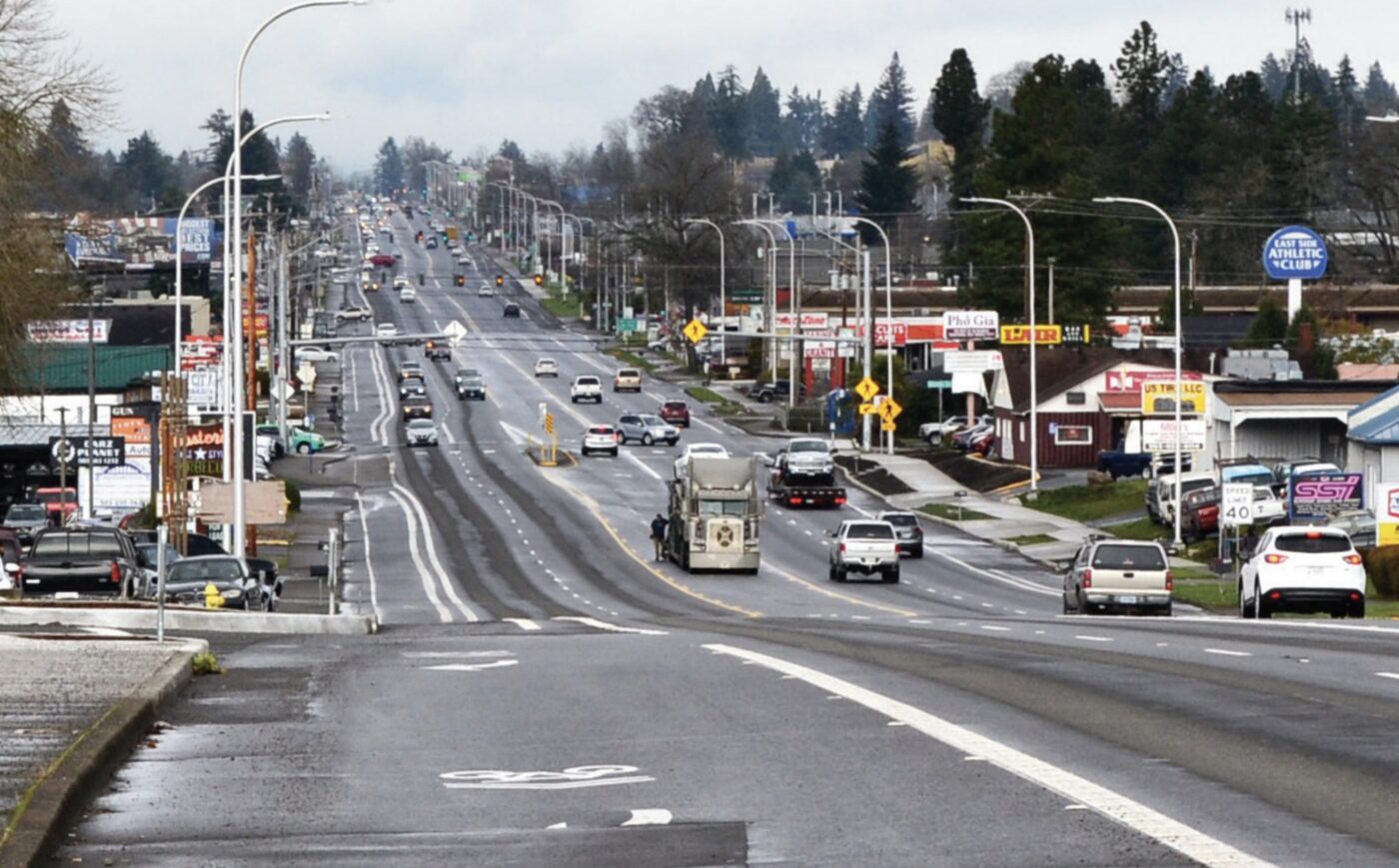
“The builders of the McLoughlin ‘super highway’ envisioned a kind of freedom no one in Oregon had experienced before. Today, we envision another kind of freedom—the freedom to navigate your neighborhood on foot, get to work on the train or bus, or ride your bike to school without worrying about getting where you are going safely.”
Believe it or not, that was written by the Oregon Department of Transportation. It’s an excerpt from the just-released draft version of their McLoughlin Boulevard Investments Strategy (you might recall our report on this back in March). It’s a joint effort between ODOT and Clackamas County to stop the bleeding on a 4.5 mile stretch of McLoughlin Boulevard (aka Highway 99E) between Milwaukie and Oregon City.
Despite being built as a highway solely for driving cars and trucks, McLoughlin serves as a main street for several cities and it’s the most important commercial corridor between I-205 and the Willamette River. And as you’d expect, it has a very sad history of crashes. In the past five years, seven people have been killed in crashes on this stretch of the road — all of them were either walking or using a wheelchair when hit. From 2016 to 2020 there were 53 crashes involving people walking and biking.
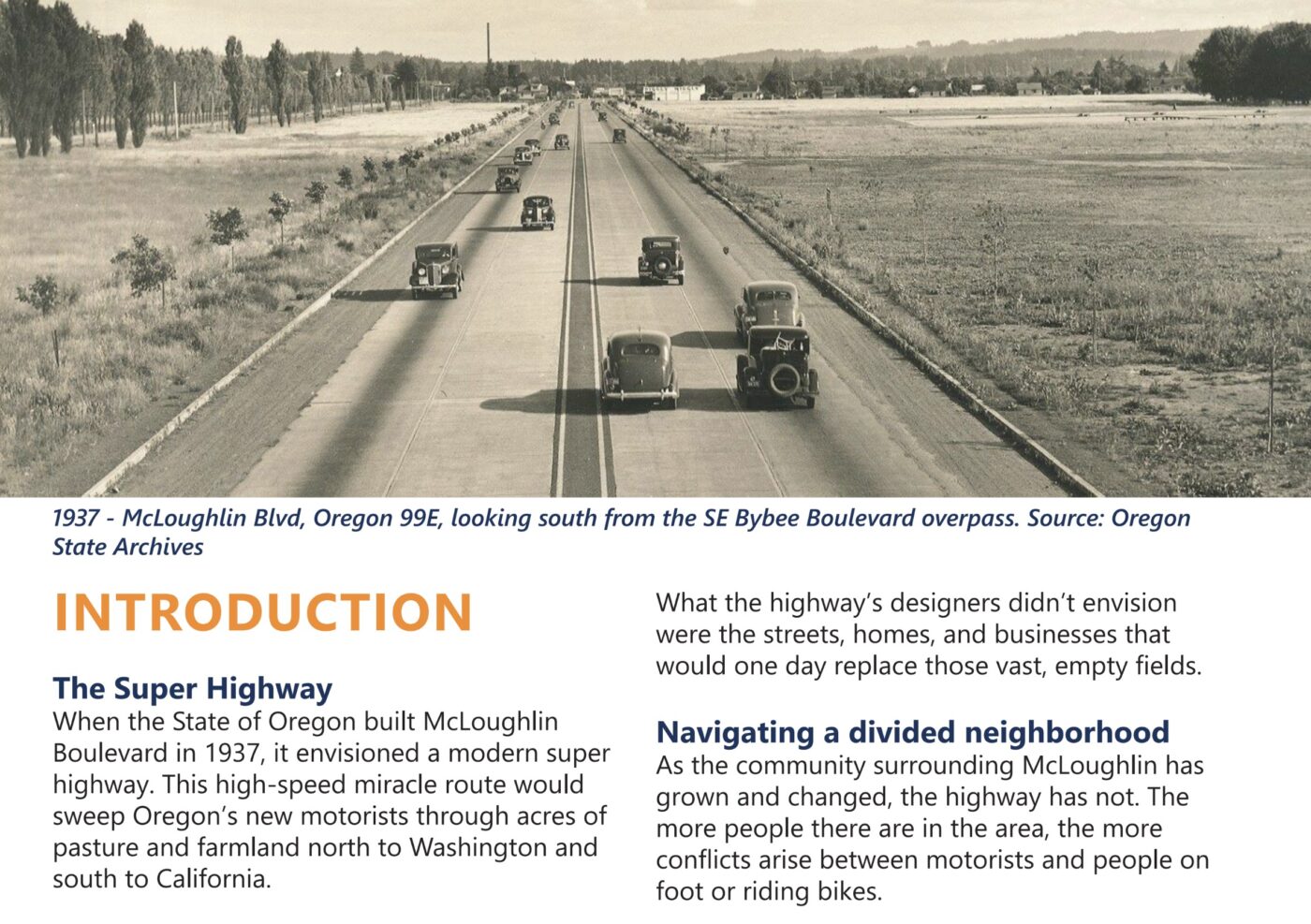

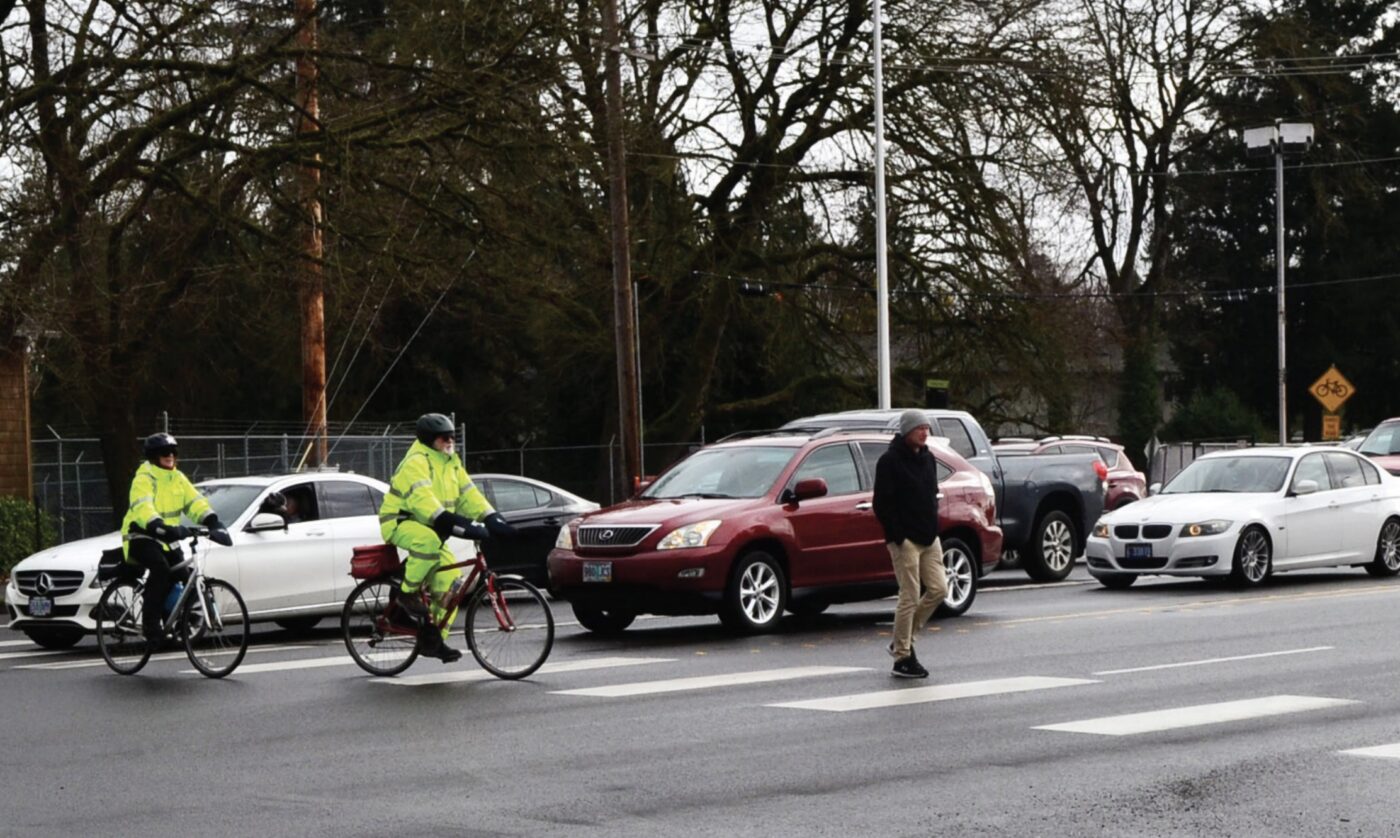

This investment strategy is the result of a year of outreach and planning work from dozens of county and state officials and advisors. And unlike other general road plans I’ve seen over the years, this one focused specifically on how to make bicycling and walking safer. The work done by this group will ensure that projects in this corridor compete better for grants and state funding in the future.
The most important part of the strategy report are the specific project recommendations. These projects can now slide right into the upcoming Statewide Transportation Improvement Program because they’ve been vetted by the public and the project team.
63 projects have been identified in the report. For each one, ODOT has assigned a very general cost estimate and feasibility score, along with a prioritization label.
Some of the projects recommended as “key investments” include: restriping the entire corridor 11-foot wide general travel lanes, to provide extra space to separate the bicycle travel lanes; add vertical separation materials inside the buffer to calm traffic and provide a greater sense of safety; reduce speed limit to 35 mph; add a landscaped median to help manage speeds; remove right-turn lanes at intersections and stripe continuous bike lanes all the way to the intersection; re-install storm drain grates at street level to reduce bumps for bicyclists; a bike-only signal at Jennings Road where the Trolley Trail crosses the highway, and so on.
It’s a solid list and it’s comforting to see ODOT and Clackamas County come together to make safe cycling more of a priority. McLoughlin Blvd was built for car drivers and it hasn’t changed much in the last century. It’s woefully outdated and doesn’t reflect the needs of many people. This plan offers us a path out of the darkness.
Check the full draft investment strategy here. The project’s community advisory committee (“sounding board”) is set to discuss the draft at their meeting July 12th. Learn more about the project here.



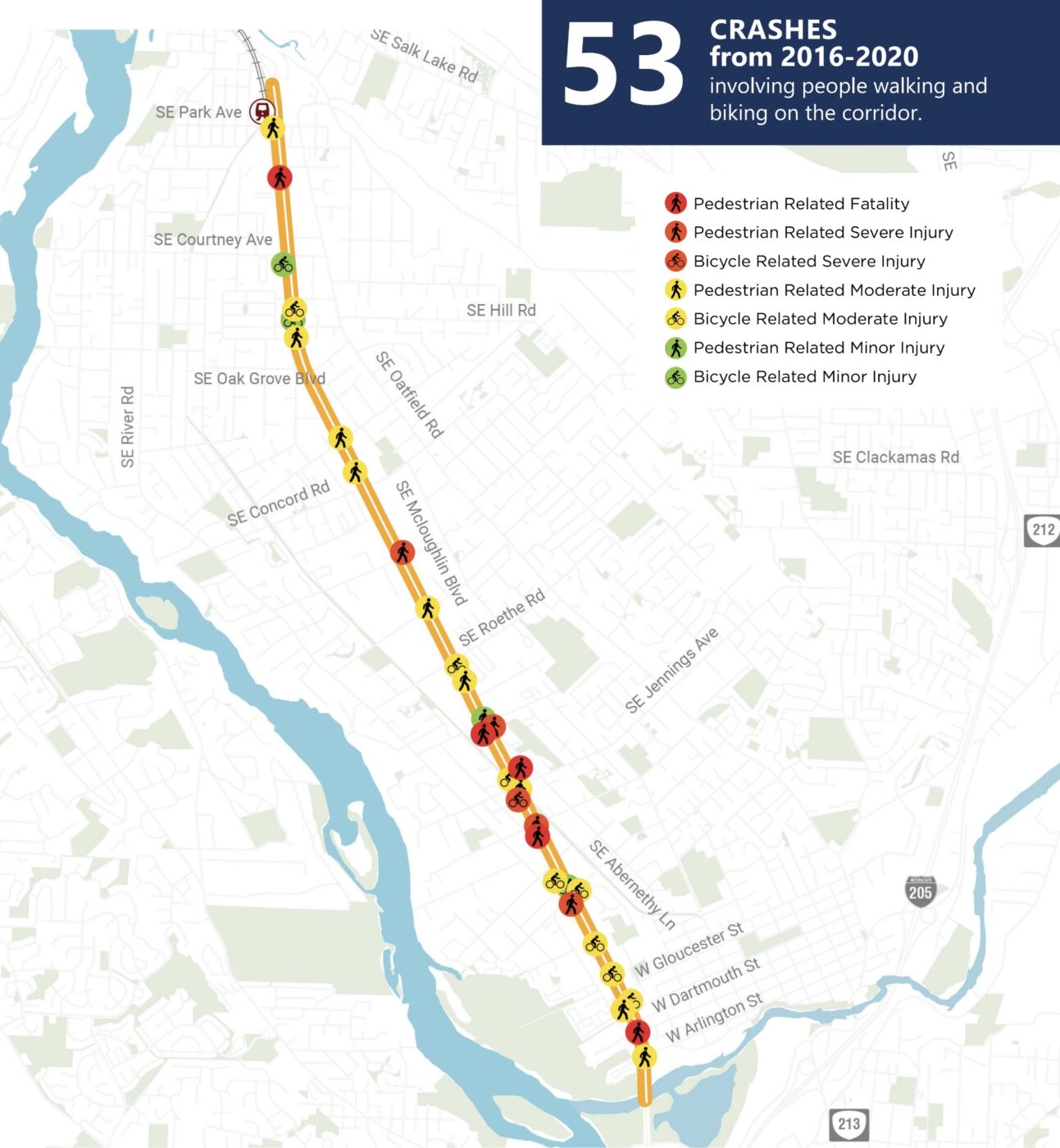
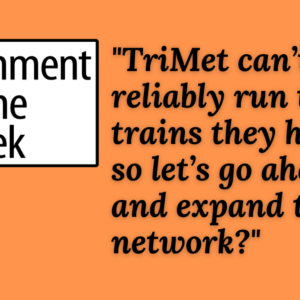
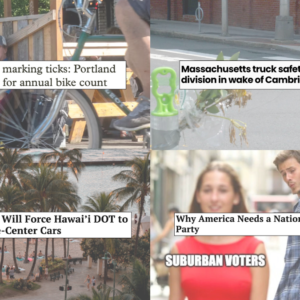
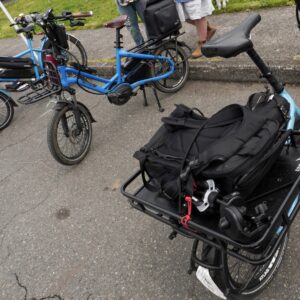
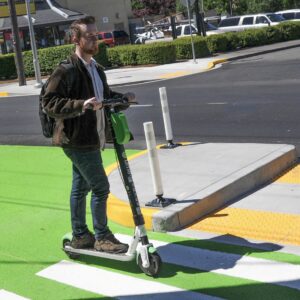
Thanks for reading.
BikePortland has served this community with independent community journalism since 2005. We rely on subscriptions from readers like you to survive. Your financial support is vital in keeping this valuable resource alive and well.
Please subscribe today to strengthen and expand our work.
I want to see light rail right down the middle of the street. This would be a good time to extend the Orange Line all the way to Gladstone.
I think just about anything would be better than an expensive and inflexible Max line. TriMet can’t even do the prescribed maintenance for its current train lines, and this would only add to their inability to keep the trains running on time or at all.
I’d much rather see better, and more flexible bus service added with better protected bike/pedestrian usage which the plan seems to strive for.
People talk about the “inflexibility” of a max line as if a highway is something flexible. There are no “flexible” transportation options in existence, and the fact that this is a high traffic corridor is not going to change. Flexibility is not important here.
But bus transit IS much more flexible than a MAX line. You’re right that the highway isn’t flexible, but the buses running on it aren’t restricted to it as ridership demands evolve.
Buses are much higher up the transportation flexibility scale than MAX trains.
But ridership demands don’t evolve, at least not to a new route. That’s my point. Since the roads don’t go away or move somewhere else, having a permanent line on one isn’t a problem. All that “evolves” is demand which you can solve by more or fewer trains. Why are we even talking about planning for some pretend future where nobody uses McGloughlin anymore?
I agree having a permanent MAX line there may not be a problem, but we were talking about flexibility, not impact of a rail line on the road.
But of course ridership demands do evolve. You’re right, you can add or subtract trains to address changing demand on the route itself. But that’s it. If demand grows past the end of the line, or to one side or another of the line, buses can go beyond or off McLoughlin to serve them. Rail can’t, without building more new lines.
I don’t know what you mean by “Why are we even talking about planning for some pretend future where nobody uses McGloughlin anymore?”
I just mean that the claim that light rail is not worth the investment because it isn’t as flexible as a bus (or cars) seems fallacious to me. The only time it would ever be not worth it is if people ever stopped needing to go where the light rail line goes, which isn’t the kind of thing that happens.
And if you find out demand grows to where you need to add more light rail, that’s not a strike against light rail, that’s in its favor. The only time it would ever have been a waste to invest in light rail is if we expect demand to dry up. Otherwise it’s a much better investment than busses especially for major high traffic corridors. Sure, branches that go off into smaller neighborhoods probably aren’t a good place for light rail (at first).
That’s not to say you can’t botch it; invest in the infrastructure and then make the service suck so bad nobody uses it. If your starting assumption is that whatever we build, it’s going to fail, then sure we should go with whatever is cheaper. I take as a given that we need heavy government investment in infrastructure to solve or mitigate problems like climate change, safety, and livability, so I’m not quite black pilled enough to think busses are the best we should aim for.
I don’t think anyone has ever said that growing demand is a negative for light rail.
The high cost of building light rail lines undermines most of your other arguments. Light rail sometimes makes sense. Buses often make much more sense.
“
Frankly I want them to build an elevated MAX line down that corridor. Something that won’t have to interface with cars and travel at full speed. I like the idea of train cars zipping overhead at 55 MPH while cars are stuck in rush hour; would make the benefits of transit readily visible. But I realize the added cost would be a tough sell for the public.
Lol – TriMet can’t reliably run the trains they have, so let’s go ahead and expand the network?
Wednesday I really wanted to take the 4:12am red line into Goose Hollow then ride the relatively flat 15 miles to Clackamas – couldn’t do that because they canceled it.
Of course, you don’t know they canceled until 4:12 comes and goes and you walk down to the only readerboard at the west end of the center platform (past a group of 5 guys smoking meth) and see the next train scheduled at 4:42.
Naturally I hopped on the trike, rode north and up out of Beaverton to Wilshire, up and over 217, up along 26, up through the Zoo to Fairview. A fast drop, then deal with the really awful roadway on lower Fairview and Park to get down to Goose Hollow (don’t even think about going up over Salmon past Lincoln – potholes big enough to lose my trike in).
Nothing like adding 8miles and 900ft of climbing to the morning commute on a day when I didn’t plan to.
Still better than the poor guy who only goes into the office 2 times a week who had to pay $$$ for an Uber to get to work in time (I chatted with him Thu morning).
Then, on the way home, I decided to ride the shortest distance to a MAX due to the smoke in the air (sucking that in is *not* good for you).
Waited 15minutes at CTC for a Green Line to show up just to hear that it was going to be stopping at Main Street – there was a MAX broken down between there and Gateway. Yep, great mainenance TriMet
Naturally I hopped off there and rode the worst section of 205 (crossing several busy streets where cyclists are very much discouraged) and through 2 small linear camps with debris all over the path.
This ignores the lack of safety officers on TriMet enforcing such basic courtesies as not playing loud music, not blocking the aisles with bikes/e-bikes and (of course) not smoking meth on the platforms.
But, yes, by all means let’s use the $ for that.
Aren’t most of Trimet’s officers paid to hang out at stations harassing disabled people/everyone they don’t like the look of & generally being menacing?
Hi Serenity,
It sounds like you might have story. I encourage you to share it.
Ah, yes! Regarding the now infamous Beaverton Transit Center max stop. You May have noticed another extra security posted there the last few years.Christine Watts lives in Beaverton & we have both testified about trikes on Trimet.She was telling me in an email that there has been a supervisor posted there permanently. TriMet posted a supervisor at BTC in March 2019, in hopes of “catching” her with her trike- which, by the way, she is able to lift and hang on the bike hook. Presumably, so they can fine and/or exclude her from TriMet property for life.
I have only personally been to BTC with my trike once since then, when I did a max ride with Betsy Reese. I checked on their bike policy again before we left, and it has not changed. Only standard two wheel bikes allowed.The employees we saw that day didn’t seem to be enforcing it. No one said anything about it. They were even helpful.
TriMet has plenty of issues, but I don’t think that means it makes sense to dismiss new rail lines out of hand. Would extending the Orange Line to Oregon City via McLoughlin really make the system as a whole more challenging to operate? I’d say probably not. If anything, it might make things a bit easier – especially if a dedicated yard gets built somewhere on the new extension. Currently, having all trains “sleep” at Ruby Junction or Elmonica is less than ideal – and probably contributes fairly heavily to cancellations in the wee hours. I know it makes it difficult to have good service on the Orange line currently in the early morning (which is why it’s common for 30 minute headways even at 8 am on weekdays).
Paying for capital projects and maintenance generally are not exactly correlated too, so it’s not like a theoretical $500 million for a new extension down McLoughlin would be coming out of the maintenance budget.
Is an Orange line extension the best possible MAX project? No, probably not. But if ODOT is trying to offload the road and the money is there now I’d say it’s worth building while the opportunity is here.
MAX should eventually reach Oregon City. I see McLoughlin light rail as a “phase 1” to get there. A Park Avenue to Arlington Street line down the middle of McLaughlin would be easy to build, and cheap by LRT standards. No land acquisitions, no displacements, no structures needed. Just tracks and stations on an existing highway.
A future Oregon City “phase 2” segment would be challenging and expensive. But that can wait.
Cheap and Max Lines are not words that ever go together in any sentence. If such a line were approved (and let’s hope it isn’t) it would be a bloated and expensive endeavor that would enrich the construction companies and do little else.
Let’s keep with the buses. At least if one breaks down it doesn’t block all the rest of the buses that are behind it.
“Cheap” is relative. Adjusting for inflation to 2023$, TriMet MAX lines cost:
Eastside line (1986): $42 MM per mile
Westside line (1998): $103 MM per mile (includes long tunnel)
Airport line (2001): $40 MM per mile
Interstate line (2004): $102 MM per mile (includes long viaduct)
Green line (2009): $98 MM per mile (includes rebuilding transit mall)
Orange line (2015): $266 MM per mile (includes river bridge, multiple structures, and buying a lot of right-of-way)
A McLoughlin line would be four miles on new track. It would be the cheapest, easiest LRT project Tri-Met has ever built. No land acquisition, no structures, no tunnels. Just laying track and building surface stations. The per-mile cost would come in at the low end of the projects above, and possibly even less.
(Phase 2 would be a one-mile extension to Oregon City Transit Center that would need a new bridge over the Clackamas river, so the cost is likely to be at the high end; $200MM or more.)
I don’t disagree that MAX (or some kind of BRT) should extend to Oregon city. I think that to really move the needle, we need a regional rail system – one that is as comprehensive as our network of highways. MAX from OC to downtown would take ages.
Lucky for us, most of a regional rail network already exists, having been built more than 100 years ago by the various predecessors of Union Pacific and BNSF. Now, is it likely that the federal, state, and local governments can develop a sane railroad policy that actually benefits the everyday schmucks in Portland rather than absentee railroad magnates in Omaha or Fort Worth? Maybe not – but the actual infrastructure does mostly exist.
This argument about LRT vs BRT is mostly irrelevant when both modes would likely take twice as long as driving to get between Oregon City and Portland. An elevated guideway in the median of McLoughlin could easily allow for track speeds of 80 mph, gapping all the motorists stuck in traffic and causing it to be the highest ridership transit route in Portland
Although it is questionable if Oregon could afford such a project, but NYU did some research for the Transit Costs Project to figure out why transit costs have skyrocketed lately, and their findings could help guide Trimet to get this built within an affordable budget.
Most of these improvements would have been funded by the 2020 transportation bond. Elections have consequences.
After watching the disastrous rollout and lack of progress, transparency and effectiveness of the Homeless Tax and the Preschool Tax I’m so glad that 2020 $4 BILLION transportation bond measure failed. What an added nightmare that would have been.
If McLoughlin had a protected bike lane from Tacoma all the way to the Hawthorne viaduct, it would be a great bike commuting route. Right now, I can choose between the Springwater (good pavement and no stop lights, but more mileage) or 17th (less mileage, but terrible pavement and lots of stop lights).
Sometimes, when I ride over 99E, I think about just riding into Portland in the breakdown lane. But it’s probably really dangerous!
What I wouldn’t give for a cycle track on 224 (end to end) and on McLoughlin to the Hawthorne viaduct.
OMG – I’d kiss the construction crews.
McLoughlin would be a horrible option even with a protected bike lane. Why not put that on Milwaukie? It’s just as flat and has a much more pleasant character. Plus, just a few stop lights (Bybee, Holgate, Powell)
Ban new drive-thrus and car dealers and change car parking mandates.
No parking is required within one half mile of McLoughlin, so that’s already done.
But new drive throughs and car lots are still allowed by right.
If the ClackCo commissioners can find a way to kill this, they will. Just like they killed the Park Ave project in 2020 (which was aimed at making the half mile radius around the Park Ave max station more livable, walkable and bikeable).
Huh, I hadn’t heard about that. Too bad.
“On June 22, 2021, the BCC directed staff to take no further action on the Park Avenue Community Project, with the understanding that if community groups in the area can come to agreement, they can come back to the BCC with a proposal in the future.”
https://www.clackamas.us/planning/parkave
No more Light Rail.
If trimet wants to go electric..just go with the electric buses with the 2 overhead power lines for them..
Experientially, I like light rail a lot more than a bus (or at least I did when the system felt safe, and for trips that don’t include the hours long slog of passing through downtown). However, as I discovered on a recent Amtrak trip, rail is singularly inflexible when a vehicle on the track ahead conks out. It can be hard to go around.
As for going electric, TriMet is firmly committed to transitioning to electric by 2050, a date so far in the future it might as well not exist. I salute the visionary leadership of an organization that can push resolving urgent problems that far into the future. Good job!
Trolleybuses benefit from also being considered “fixed route transit” by the FTA, and eligible for different types of funding. However, you will be disappointed to know that TriMet did not even consider trolleybuses when studying bus electrification options in 2018.
Why? I am not really sure. Chicago abandoned their legacy trolleybus infrastructure after a particularly bad winter storm crippled the fleet in the 60s (since they could not get around abandoned vehicles) – not too different than the historical reason for the development of the New York Subway ironically. Seattle and San Francisco both have fairly extensive trolleybus networks, and have similar enough climates to Portland that I don’t really think there is a compelling weather related reason to not pursue trolleybuses.
Maybe I need to find my way to a TriMet public meeting about bus electrification, if they ever have one